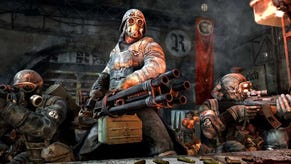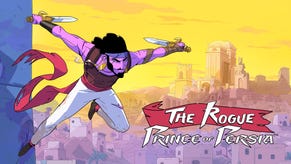Going underground - Metro: Last Light revealed in London
Metro: Last Light, the sequel to Eastern European post-society horror Metro 2033, is looking to refine and build. Stace Harman took a first look at the game's announcement event.
Huw Beynon, head of THQ’s global communications, wants to set the record straight: “It was never going to be called Metro 2034,” he tells the assembled journalists, many of whom have flown into London from various parts of Europe to see this eyes-only unveiling of the sequel to last year’s bleak survival horror FPS, Metro 2033.
“The first game was based on Dmitry Glukhovsky’s post-apocalyptic novel, Metro 2033. He did write a pseudo-sequel called Metro 2034 but whilst the setting and concept of the first book leant themselves to a videogame, the second novel was a stab at an esoteric art-house style so wouldn’t work so well in this format. We referred to this game as 2034 internally because it was easier to call it that, but that was never actually the title.”
Titles aside, Last Light picks up where 2033 left off, though with two very different endings achievable in the first game depending on protagonist Artyom’s actions Ukrainian developer 4A Games has had to choose which narrative strand to continue - if you’re thinking of playing the first game prior to Last Light’s 2012 launch and don’t want to know how 2033 ends, skip ahead to the next paragraph – perhaps fittingly, given the tone of the first game, Last Light continues from the bleaker, more pessimistic ending that saw Artyom facilitate the destruction of the Dark Ones, believing them to be a threat to the inhabitants of the entire metro system.
Going underground
The titular Russian metro system houses the last vestiges of human life after one of those pesky apocalyptic events scorched the earth and left the surface a barren and poisonous wasteland a couple of decades past. The surface is uninhabitable, but living underground is no picnic either.
“The average metro dweller can expect to live a short, harsh life that will ultimately end with some unpleasant respiratory disease,” Beynon explains “An entire generation has been born and raised underground and they’ll likely not travel more than 500 yards from where they were born throughout their whole lives. The outside world, sky and sunshine are all alien concepts to them.”
The metro stations have evolved to form separate city-states, some controlled by extreme factions like the fascist neo-Nazis of Reich and the hard-edged communists of Red Line. As Artyom is propelled through Last Light’s narrative he’ll come into contact with these factions, though there will be no choice to side with a particular group as 4A Games is intending to deliver a linear, tightly scripted experience. Instead, Beynon explains that player expression will be in the form of the tactics you employ to get through different areas of the game.
“Our fans really liked the larger levels from the first game,” he tells us. “Such as Black Station, where you could take multiple routes through the level and it felt organic and open-ended. We’ll have more of these in Last Light and allow you take these multiple routes and employ different tactics in order to satisfy that need.”
As before, light plays an intrinsic part of your arsenal and we’re shown the various ways in which light, or more specifically its absence, can help balance the odds and increase your chance of survival in the underground tunnels. Electric lights can be shot out or, in a neat touch, the wall mounted bulbs removed for a quieter, stealthier approach. At one point an open fire is extinguished with a few well placed silenced gun shots: a few scattering the logs that are feeding it and a couple more overturning a pot of water that’s hanging above the fire. If 4A consistently facilitate this option for stealth throughout the entire game then light and dark could play as significant a role here as it did in the decade old and highly atmospheric Thief series.
Backing up this gameplay-orientated use of light are some impressive tech effects. Metro 2033 was lauded for its technical achievements and Last Light looks to be continuing that trend. We see how the protagonist’s lighter flares in the darkness and sets alight some low hanging cobwebs, sending the large arachnid inhabitants scurrying away from the flames. During a gun fight a number of cardboard boxes catch alight, the fire spreads and Beynon explains that they are “looking to implement the lighting effects in cool ways and so, depending on the materials present around you, the fire will spread naturally. We won’t have every pile of boxes set alight and collapsing in the same way.”
It’s the team’s intention that by the time the game launches it will be a “poster child” for the latest and most powerful graphics cards, as well as delivering a great looking game on consoles (unlike its predecessor Last Light will see a PS3 launch, alongside the 360 and PC).
“The PC version will be technically superior to the console version,” Beynon confirms “That’s just the reality of where we are at the moment in the console cycle, if you have a high-end PC it’ll be able to do things that are beyond the capabilities of the consoles but the goal for the studio is to create something that will push boundaries whatever platform it’s on. We’re confident that the console versions will look as good as anything else on those platforms but if you have that high-end PC you’ll get performance out of Last Light that you can’t get elsewhere.”
More bang for your buck
It’s worth noting that the demo we’re shown has been specifically created for this unveiling and to be shown off at E3, this being the case Beynon states that it does not necessarily represent a level from the final game but is instead intended to give a flavour of gameplay techniques and showcase the team’s technical prowess whilst standing out at a crowded E3.
As such, much is yet to be decided about the full list of features that will be present in the final release. One of these debates currently surrounds the first game’s trading mechanic, in which you used bullets as currency. It was a system that was loved by some and loathed by others with detractors complaining that it took the gritty, scavenge/survival mechanic too far and effectively prevented use of the more interesting and powerful weapons in the game, a criticism that Beynon acknowledges as valid. No specific numbers were announced but Beynon did confirm that the team are adding more weapons to the roster - all adhering to the improvised and handmade ethos that reflects the post-apocalyptic setting. So, with more guns on offer can the bullets-as-currency system return without undermining the expanded arsenal?
“[Bullets as currency] was a concept taken from the book and that we really wanted to bring into the game world,” Beynon explains “We’ve added more weapons and we’re looking at how the player will go about acquiring guns and new equipment. We want to maintain that scarcity of equipment from the first game but not to the point that it impacts your opportunity to play with the new toys that we want you to experience.”
Reading between the lines, it seems likely that the bullet currency concept will be done away with, but as Beynon reiterates: nothing has been decided yet.
The narrative details were not discussed at any length, though it’s confirmed that there will be more focus on the Rangers this time around, leading to increased interaction with them and examination of their role in the Metro world. Multiplayer will also be making an appearance, with Beynon telling us that they had wanted to include it in the first game but did not have sufficient time or resource to do it justice, there’s no word on whether the multiplayer will take the form of co-op and/or versus modes at this stage.
It will be interesting to see how Last Light develops over the coming months; a refinement of the mechanics from the first game combined with the gritty bleakness of 4A’s vision of a post-apocalyptic Russia topped with THQ’s greater commitment to the title should help Metro: Last Light build on the solid but not spectacular performance of its predecessor.
As Beynon sums up: “We’ve shown you part of it here today, but it’s far from the whole story and there’s a lot more to come.”
Metro: Last Light launches for PC, 360 and PS3 in 2012.














.jpg?width=291&height=164&fit=crop&quality=80&format=jpg&auto=webp)



.png?width=291&height=164&fit=crop&quality=80&format=jpg&auto=webp)

